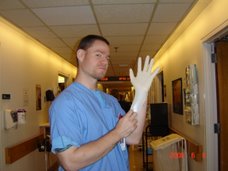
http://phstwlp1.partners.org:2075/ghttp://phstwlp1.partners.org:2075/gw1/ovidweb.cgiw1/ovidweb.cgihttp://phstwlp1.partners.org:2075/gw1/ovidweb.cgiw1/ovidweb.cgi
IN 2005, WE BEGAN a six-part series of articles that has focused on the registered nurse (RN) workforce in the United States (Buerhaus, 2005). In preceding articles we reported results of analyses designed to assess: (a) whether the current nursing shortage is getting better or worse (Buerhaus, Donelan, Ulrich, Norman, & Dittus, 2005a); (b) RNs' satisfaction with their jobs and with being a nurse (Buerhaus et al., 2005b); (c) awareness and impact of a major national initiative aimed at drawing attention to the nursing shortage, promoting the image of nurses, and attracting people into the nursing profession (Donelan, Buerhaus, Ulrich, Norman, & Dittus, 2005); (d) the impact of the current nursing shortage on nurses, care processes, and on the quality of patient care (Buerhaus et al., 2005c; and (e) characteristics of older RNs, the fastest growing segment of the nursing workforce in the United States (Norman et al., 2005). These analyses used trended data from national surveys of RNs conducted in 2002 and 2004, as well as a 2003 national survey of nursing students, and a 2005 national survey of chief nursing officers (CNOs). The surveys were conducted as part of a project designed to determine the effectiveness of the Johnson & Johnson Campaign for Nursing's Future (Buerhaus, 2005).
In this article, we pull together key results of these national surveys to provide a comprehensive assessment of the state of the nursing workforce in the United States. Overall, we believe that nurses are telling us that workforce conditions have improved since 2002 when the current nursing shortage, which began in 1998, was at its peak. At the same time, there are lingering problems that, unless resolved, threaten to erase the recent gains that have been achieved and disrupt efforts to accomplish long-term improvements in the clinical workplace environment. If the profession is to thrive, change must continue apace — short-term fixes have failed before. Whether further improvements or setbacks develop over the next few years will depend on how effectively nurses, policymakers, the private sector, and hospital leaders act to address the implications of the current and projected nursing shortage.
IN 2005, WE BEGAN a six-part series of articles that has focused on the registered nurse (RN) workforce in the United States (Buerhaus, 2005). In preceding articles we reported results of analyses designed to assess: (a) whether the current nursing shortage is getting better or worse (Buerhaus, Donelan, Ulrich, Norman, & Dittus, 2005a); (b) RNs' satisfaction with their jobs and with being a nurse (Buerhaus et al., 2005b); (c) awareness and impact of a major national initiative aimed at drawing attention to the nursing shortage, promoting the image of nurses, and attracting people into the nursing profession (Donelan, Buerhaus, Ulrich, Norman, & Dittus, 2005); (d) the impact of the current nursing shortage on nurses, care processes, and on the quality of patient care (Buerhaus et al., 2005c; and (e) characteristics of older RNs, the fastest growing segment of the nursing workforce in the United States (Norman et al., 2005). These analyses used trended data from national surveys of RNs conducted in 2002 and 2004, as well as a 2003 national survey of nursing students, and a 2005 national survey of chief nursing officers (CNOs). The surveys were conducted as part of a project designed to determine the effectiveness of the Johnson & Johnson Campaign for Nursing's Future (Buerhaus, 2005).
In this article, we pull together key results of these national surveys to provide a comprehensive assessment of the state of the nursing workforce in the United States. Overall, we believe that nurses are telling us that workforce conditions have improved since 2002 when the current nursing shortage, which began in 1998, was at its peak. At the same time, there are lingering problems that, unless resolved, threaten to erase the recent gains that have been achieved and disrupt efforts to accomplish long-term improvements in the clinical workplace environment. If the profession is to thrive, change must continue apace — short-term fixes have failed before. Whether further improvements or setbacks develop over the next few years will depend on how effectively nurses, policymakers, the private sector, and hospital leaders act to address the implications of the current and projected nursing shortage.




No comments:
Post a Comment